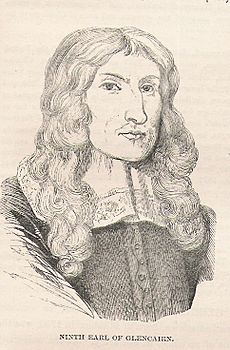Glencairn's rising facts for kids
Quick facts for kids Glencairn's rising |
|||||||
|---|---|---|---|---|---|---|---|
| Part of Wars of the Three Kingdoms | |||||||
|
|||||||
| Belligerents | |||||||
| Commanders and leaders | |||||||
| Strength | |||||||
| 3,500 foot and 1,500 horse | Unknown | ||||||
| Casualties and losses | |||||||
| Unknown | Unknown | ||||||
Glencairn's rising was a rebellion in Scotland from 1653 to 1654. It was led by people who supported King Charles II. These supporters were called Royalists. They were fighting against the government of Oliver Cromwell, known as the Protectorate.
The rebellion was led by William Cunningham, 9th Earl of Glencairn. King Charles II had given him command of the Royalist forces in Scotland. At first, the rebellion did well. But then, problems started when John Middleton arrived. He was sent to take over from Glencairn as the main commander. This led to arguments and even fights between officers.
The rising was finally defeated on 19 July 1654. A force led by Thomas Morgan surprised Middleton's army at a place called Dalnaspidal. Even though the rebellion failed, it made Cromwell's government change its approach. They decided to try and make peace with former Royalists and other groups who had opposed them.
Contents
Starting the Rebellion
The rebellion began in August 1653. William Cunningham, 9th Earl of Glencairn gathered important Scottish leaders at Lochearn. These leaders included John Murray, 1st Marquess of Atholl and Archibald Campbell. Also present were Donald MacDonell of Glengarry and Ewen Cameron of Lochiel.
These leaders then called on their followers to join the fight. They formed a small army. It had about 60 horsemen and 210 foot soldiers. The foot soldiers were a mix of Lowlanders and Highlanders. The governor of Stirling Castle, Colonel Kidd, tried to stop them. But Glencairn's forces defeated him at Aberfoyle. This victory made the rebels more confident. It also encouraged some Lowland Scottish lords to support the rising. This forced Cromwell's government to become more understanding towards these groups.
Problems Among the Rebels

Even though more people joined, the rebellion started to have internal problems. There were disagreements, especially between the Highlanders and the Lowland nobles who led them. The Highlanders made up most of the fighting force.
In early 1654, about nine months into the rebellion, John Middleton arrived. He was a Lowland officer and a skilled soldier. King Charles II had sent him to take command. Glencairn gave up control of his forces, even though his followers disagreed. By this time, the rebel army had grown to 3,500 foot soldiers and 1,500 horsemen.
The problems were often small arguments between Glencairn's and Middleton's groups. One evening, Sir George Munro, who worked for Middleton, insulted Glencairn's soldiers. This led to a fight between Glencairn and Munro, and Munro was hurt. Glencairn was then arrested. He was later set free and left the rebellion. The next day, two younger officers from the different groups also fought. One was killed, and the other was arrested and later hanged. Many other arguments and fights happened. These problems weakened the leadership of the rebellion until it ended.
The Rebellion's End
Middleton decided to use a strategy of quick attacks and raids. This helped to distract Cromwell's forces and cause problems for them. However, it also made the rebels unpopular. People stopped joining the army.
When George Monck returned to Scotland, he began a strong campaign against the rebels. His soldiers marched long distances every day, even in difficult areas. On 19 July 1654, a part of Monck's army, led by Thomas Morgan, found Middleton's army at Dalnaspidal.
In the battle that followed, the Royalist forces were scattered. Middleton was wounded and had to escape into the Highlands. The war with the Dutch had ended, meaning no help would come from other countries. Also, the government now had more soldiers to send against the rebellion. Because of this, the Royalist military effort slowly stopped. Glencairn eventually surrendered to Monck. Middleton escaped to Europe to join King Charles II's court, which was in exile.
What Happened Next
Even though Glencairn's rising failed, it made Cromwell's government change its plans. Instead of trying to completely replace the powerful landowning families, they decided to try and make peace. They wanted to get along with former Royalists and other groups who had fought against them.
This change led to something called the Act of Grace and Pardon. It was announced in Edinburgh on 5 May 1654. Instead of taking away land from everyone who had resisted, the Act named 24 people (mostly nobles) whose lands would be taken. It also named 73 other landowners who could keep their land after paying a fine. Even for those named, the government was often kind. Fines were reduced or even cancelled, and some land confiscations were dropped.
See also

